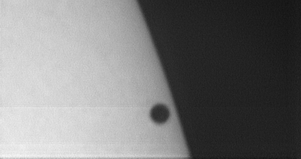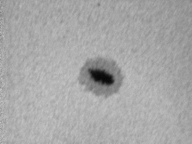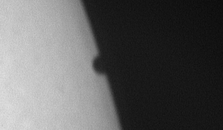Transit of Mercury 7th May 2003

The Mercury transit was going to last from 05:11 to 10:33 UT. Rather than get up early and deal with it before work, I took the day off to make use of the later stages of the transit. In my garden the Sun climbs above the neighbour's roof only at 06:35. The thin cloud cover that formed overnight is burnt away around 06:00, leaving enough time to set up the telescope, webcam and laptop. I am well used to the equipment from a number of times when I imaged sun spots.

The front of the 200 mm aperture Schmidt-Cassegrain is covered with a special double foil filter (SolarSkreen). Instead of an eyepiece there is a 2x photo adapter in front of the Cassegrain focus, followed by a Philips ToUcam Pro webcam with its lens removed. In total this gives a focal length of about 3500 mm, f/17.5. Each of the 640x480 webcam pixels is about a third of an arcsecond in size.
The webcam is wired up via USB to the laptop, where the Linux pwc and pwcx modules feed the data into the qastrocam application. "Captures" of 100 frames each (20 seconds) are written to disc in PPM format. These frame sets are later aligned with each other and averaged, then unsharp masked for the final images.

Initially the seeing is quite good (see the image of the large sunspot), in spite of some cirrus up in the sky. Mercury - apart from being perfectly round and having no penumbra - is not terribly interesting at this time, as it is far from the solar limb.
The weather takes a turn for the worse, but around 10:15 things are looking up again: Cumulus clouds line up to pass between me and the Sun, sometimes not closing the gap between them. Just when it becomes really interesting there are fortunately enough cloud gaps to get some reasonable images. The two mercury images are just before third contact and about halfway between third and fourth contact.